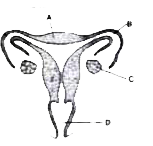[A] : Placenta is a tissue in eutherian mam- mals that has both embryonic and maternal tissue.
[R]: In mammals, foetal components of the placenta derive from trophoblast.
If both A and R are true and R is the correct explanation of A
If both A and R are true but R is not the correct explanation of A
If A is true and R is false
If both A and R are false
The correct Answer is:A
Step by step video & image solution for [A] : Placenta is a tissue in eutherian mam- mals that has both embryonic and maternal tissue. [R]: In mammals, foetal components of the placenta derive from trophoblast. by Biology experts to help you in doubts & scoring excellent marks in Class 12 exams.
Updated on:21/07/2023Topper's Solved these Questions
Similar Questions
Assertion : In placental mammals the placenta is connected to the embryo by the umblical cord and has an essential role in the immunological protection of the embryo .
Reason : In mammals foetal components of the placenta derive initially from the chondroblast connected with embryonic derive initially from he chondroblast connected with embryonic blood stream either through its contact with the yolk sac.
View SolutionAssertion: Placenta is connected to the fetus by an umbilical cord.
Reason: Fetal components of placenta are derived from endometrium.
View SolutionAssertion : Placenta is combined structure of foetal tissue & maternal tissue
Reason : Placenta formation is completed before 6 weeks of pregnancy .
View SolutionA : placenta is connected to the embryo through an umbilical cord which helps in the transport of substance to and from the embryo
R : Palcenta acts as an endocrine tissue
View SolutionThe chemical substance P is made and secreted by the meristematic tissue at the tip of stem (or shoot) of a plant. The chemical substance P is responsible for a phenomenon Q in plants in which the stem bends towards the source of light. The same chemical substance P has an opposite effect on the root of a plant. It causes the root of a plant to bend away from the source of light in a process called R.
State whether P prefers to remain in the sunlit side of a stem or in shade.
View SolutionThe chemical substance P is made and secreted by the meristematic tissue at the tip of stem (or shoot) of a plant. The chemical substance P is responsible for a phenomenon Q in plants in which the stem bends towards the source of light. The same chemical substance P has an opposite effect on the root of a plant. It causes the root of a plant to bend away from the source of light in a process called R.
What is the general name of the chemical substance like P ? Name another substance which belongs to this class of chemical substances.
View SolutionThe chemical substance P is made and secreted by the meristematic tissue at the tip of stem (or shoot) of a plant. The chemical substance P is responsible for a phenomenon Q in plants in which the stem bends towards the source of light. The same chemical substance P has an opposite effect on the root of a plant. It causes the root of a plant to bend away from the source of light in a process called R.
What is the effect of substance P on the rate of growth of
(a) a root and (b) a stem?
View SolutionSelect correct combination of statements for lymph.
i. It helps to maintain fluid balance of the body.
ii. It is contained in lymphatic vessels and lymphatic organs in mammals.
iii.It is derived from tissue fluid.
iv. It contains less antibodies than plasma.
v. It flows in both directions.
View SolutionGiven below are the steps involved in parturition. Arrange them in proper sequence and select the correct option.
I. The induction of mild uterine contractions is called foetal ejection reflex.
II. Stronger uterine contractions causing the further release of oxytocin. III. Origination of signals from the fully developed foetus and placenta.
IV. Release of oxytocin from maternal pituitary
V. Expulsion of baby from the birth canal
(a) III , IV , I , II , V
(b) III, I , IV , II , V
(c) I, III , II , IV ,V
(d) II , IV , III, I,V
View SolutionThe figure given below represents the female reproductive system of a mammal. Parts indicated by the guidelines A to D are as follows:

(A) Uterus
(B) Fallopian tube (oviduct)
(C) Ovary
(D) Vagina
(a) Give appropriate terms for each of the following:
(i) The onset of reproductive phase in a young female.
(ii) Rupture of follicle and release of ovum from the ovary
(iii) Monthly discharge of blood and disintegrated tissues in human female.
(iv) Process of fusion of ovum and sperm.
(v) Fixing of developing zygote on the uterine wall.
(vi) The permanent stoppage of menstruation at about the age of 45 years in a female.
(b) State the functions of the (0) Placenta (ii) Amniotic fluid. [ICSE 2004, 2015]
(c) Using the symbol "X' indicates the region in the diagram where fertilisation occurs.[ICSE 2004)
View Solution
